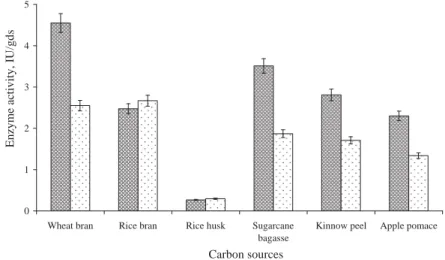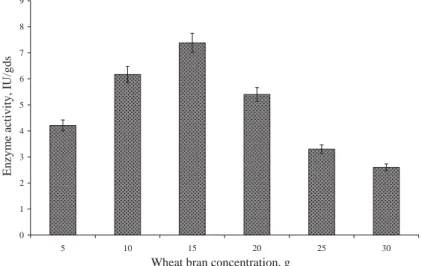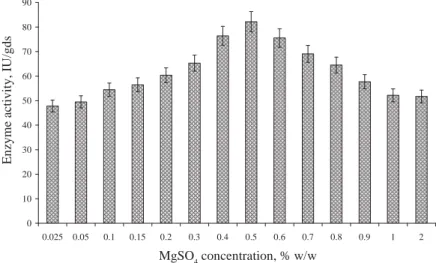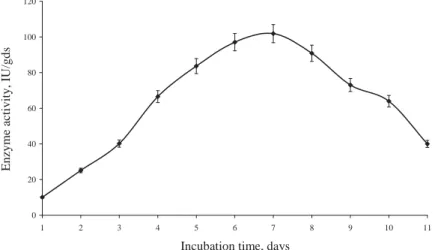0139–3006 © 2018 Akadémiai Kiadó, Budapest DOI: 10.1556/066.2018.47.2.4
UTILIZATION OF AGRO-INDUSTRIAL RESIDUES FOR THE PRODUCTION OF β-GALACTOSIDASE USING FUNGAL ISOLATE
UNDER SOLID STATE FERMENTATION CONDITIONS
R. KAURa, P.S. PANESARa* and R.S. SINGHb
aFood Biotechnology Research Laboratory, Department of Food Engineering & Technology, Sant Longowal Institute of Engineering and Technology, Longowal-148106, Punjab. India
bDepartment of Biotechnology, Punjabi University, Patiala 147 002. India (Received: 24 April 2017; accepted: 17 October 2017)
β-Galactosidase is an enzyme of commercial importance owing to its multiple benefi ts. Among all microbial sources, fungal species are of great interest for the production of this enzyme. Thus, the aim of this present work was to optimize the media as well as process parameters to achieve maximum β-Galactosidase production by solid state fermentation using the fungal isolate Rhizomucor pusillus. Various agro-industrial residues were tested for carbon as well as for nitrogen sources. The different process parameters were also studied to observe their effects on β-galactosidase production. Among all screened agro-industrial residues, wheat bran and corn steep liquor had the potential to be used as carbon and nitrogen sources, respectively; whereas MgSO4 was found to be a suitable salt supplement. The optimal process parameters included particle size of 1000 microns, 50% moisture content, pH 5.5, 50 ºC temperature, and 7 days of fermentation.
Keywords: β-galactosidase, agro-industrial residues, fermentation, optimization, Rhizomucor pusillus
Among all food grade enzymes, β-galactosidase has a signifi cant potential in the food industry owing to its numerous health related benefi ts. β-Galactosidase (E.C. 3.2.1.23) or lactase has the ability to catalyze hydrolysis as well as transgalactosylation reaction, with the formation of monosaccharides or prebiotics, respectively. Both these reactions are of prime importance and thus, this enzyme has commercial value, not only in the food but also in the pharmaceutical sectors (SEN et al., 2014).
β-Galactosidase occurs widely in nature and has been extracted from different plants, animals as well as microorganisms (KUMARI et al., 2011). In contrast to all the natural sources, microorganisms are the preferred sources in terms of their technical as well as economical benefi ts. Amongst all microbes, β-galactosidase from fungus is of special interest as the enzyme synthesized is extracellular in nature and has broad stability (AWAN et al., 2010a;
AKCAN, 2011).
Agro-industrial residues or wastes are those which are generated from the food as well as agricultural industries or from the agricultural practices. Being rich in cellulose, hemicellulose as well as in other nutrients, these wastes are one of the main reasons for pollution and therefore should be used as potential substrates for microbial fermentation rather than considering them as wastes (RODRIGUEŹ , 2008).
Keeping in view of the above, the present study was conducted to optimize the media as well as process parameters for the production of β-galactosidase using fungal isolate Rhizomucor pusillus to obtain high yield of enzyme by SSF.
* To whom correspondence should be addressed.
Phone: +91-1672-253252; fax: +91-1672-280057; e-mail: pspanesarrr@yahoo.com
1. Materials and methods
1.1. Microorganisms
β-Galactosidase producing fungal culture was isolated from rotten banana peel and identifi ed as Rhizomucor pusillus. The identifi cation studies were carried out in the Institute of Microbial Technology (IMTECH), Chandigarh, India. The phenotypic characterization was carried out using maximum likelihood model based on Tamura-3 parameter model, and the genotypic characterization was done using 5.8S rRNA gene sequence data. The fungal strain was grown on modifi ed Czapek Dox agar with the following composition in g l–1: lactose 20 (w/v);
peptone 10 (w/v); yeast extract 10 (w/v); ammonium sulphate 5 (w/v); potassium di-hydrogen phosphate 1 (w/v); di-potassium hydrogen phosphate 3 (w/v); magnesium sulphate 0.5 (w/v), and ferrous sulphate 0.3 (w/v). The strain was incubated at 50 °C for 8 days (CI 10S, Remi Instruments Pvt. Ltd.) and the culture was maintained at 4 ºC until further use.
1.2. Inoculum preparation
Inoculum was prepared from the 9 days fully grown culture on Czapek Dox agar plates.
Spore suspension was prepared using sterile distilled water containing 0.01% triton X-100 on the Petri plates and the spores were dislodged with sterile loop. The spore count was determined using a haemocytometer. Spore suspension was used for the production of enzymes under SSF.
1.3. Optimization of media and process parameters
The preliminary optimization of the media and the process parameters was carried out to determine their effect on the β-galactosidase production. Different agro-industrial residues (wheat bran, rice bran, rice husk, sugarcane bagasse, kinnow peel, and apple pomace) were tested for their potential as carbon sources by using 5 g each in the respective fl asks, supplemented with (NH4)2SO4 at 3% (w/w). The substrate was moistened using two different moistening agents, such as deproteinized whey and sterile distilled water. The particle size of the chosen substrate varied from 200–3000 microns. Moreover, different nitrogen sources (urea, sodium nitrate, peptone, ammonium sulphate, ammonium nitrate, yeast extract, casein, corn steep liquor (CSL), fi sh scale, pea pod, and soya okara) were individually supplemented at the concentration of 3% (w/w), in case of CSL, 3% (v/w), to the fermentation medium to investigate the effect on the enzyme production using wheat bran as a carbon source (15 g).
The effect of different salt supplements on the enzyme production had been studied by adding MgSO4, ZnSO4, FeSO4, and CaCl2 (0.2% w/w) to the medium containing wheat bran as carbon and CSL as nitrogen source.
The process parameters such as particle size (200–3000 microns), moisture content of the media (40–90%), pH (3–9), inoculum spore density (1×104 – 1×109 spores/ml), temperature (40–70 °C), and incubation time were also tested to get the optimum conditions for the maximal enzyme production.
1.4. Extraction of the enzyme
The crude enzyme was extracted by mixing the fermented substrate with sodium citrate buffer (pH 4.5) in the ratio of 1:10. The mixture was agitated in the shaker (MSW-132, MAC, India) for 1 h. The mixture was fi ltered through a muslin cloth by squeezing and further
164
centrifuged at 7000–8000 r.p.m. (REMI C-24BL) for 10 min. The clear supernatant obtained after centrifugation was assayed for the β-galactosidase activity.
1.5. Determination of the enzyme activity
The enzyme assay was carried out by following the method of RECZEY and co-workers, (1992) along with some modifi cations. The culture was centrifuged at 7000–8000 r.p.m. for 10 min. The supernatant was used for enzymatic assay. The enzyme solution (0.2 ml) was mixed with 1 ml o-nitrophenyl-β-galactosidase (ONPG) (2.5 mg ml–1) in sodium citrate buffer (0.1 M, pH 4.5). The enzyme solution along with the substrate was incubated at 50 ºC for 5 min. The reaction was stopped by using 1 ml of sodium carbonate (10%) and the absorbance was read at 420 nm (DR 5000, HACH, Germany).
One unit of enzyme activity is equivalent to 1 micromole of ortho-nitrophenol liberated per min under standard assay conditions.
2. Results and discussion
The optimization of media and process parameters had been carried out to obtain maximal β-galactosidase production. The results have been summarized in the following sections.
2.1. Effect of the carbon sources
Among the various carbon sources tested, wheat bran gave the maximal enzyme activity of about 4.55 IU/gram dry substrate (gds) using deproteinized whey as the moistening agent (Fig. 1), whereas using distilled water as a moistening agent resulted in low yield (2.55 IU/gds). However, rice bran exhibited the maximal enzyme activity of 2.67 IU/gds using water as a moistening agent. Moreover, wheat bran concentration varied from 5 to 30 g, and the maximal enzyme activity of 7.38 IU/gds was achieved using 15 g of wheat bran (Fig. 2). Wheat bran contains high hemicellulose as well as sugar contents and other nutrients, which makes it suitable to be used as a substrate (AWAN et al., 2010b).
0 1 2 3 4 5
Wheat bran Rice bran Rice husk Sugarcane bagasse
Kinnow peel Apple pomace
Carbon sources
Enzyme activity, IU/gds
Fig. 1. Effect of carbon sources on β-galactosidase production : Whey; : water
0 1 2 3 4 5 6 7 8 9
5 10 15 20 25 30
Wheat bran concentration, g
Enzyme activity, IU/gds
Fig. 2. Effect of wheat bran concentration on β-galactosidase production
β-Galactosidase production using various agro-industrial residues under solid state fermentation had been tested by RAOL and co-workers (2015). Their study also revealed the maximal enzyme production using wheat bran as a substrate moistened with deproteinized cheese whey.
2.2. Effect of particle size
The results depicted in Figure 3 reveal that the particle size of the substrate had a signifi cant effect on the enzyme activity. The maximal enzyme activity of 17.55 IU/gds was achieved using 1000 microns particle size, after which a further increase in the size resulted in lower enzyme yields.
MgSO4
Urea
200 FeSO4
300 Sodium nitrate ZnSO4
600 Peptone CaCl2
1000 Ammonium nitrate
2000 Ammonium sulphate
3000 Yeast extract Corn steep liquor
Casein Fish scale Pea pod Soya okara
0 5 10 15 20 25 30 35 40 45 50 55 60 65 70 75 80 85 90
t n e m e l p p u s t l a S e
c r u o s n e g o r t i N e
z i s e l c i t r a P
Enzyme activity, IU/gds
Fig. 3. Effect of media parameters on β-galactosidase production
166
Smaller particle size allows nutrient absorption as well as limits oxygen diffusion and helps assimilation of mycelia as it provides larger surface area, whereas larger particle size of the substrate gives less surface area. Furthermore, too small particle size leads to the formation of lumps, which may affect the availability of the nutrients to the microorganisms and creates anaerobic environment (HATZINIKOLAOU et al., 2005).
2.3. Effect of nitrogen sources
Among the various sources, highest activity (21.27 IU/gds) was observed with corn steep liquor as a nitrogen supplement followed by ammonium sulphate (18.56 IU/gds) as demonstrated in Figure 3. Besides, the enzyme activity increased from 60.98 to 71.38 IU/gds when the concentration of CSL was increased from 5 to 7% (v/w), after which with further increase in the concentration up to 20%, a decrease in the activity was observed (Fig. 4). The high enzyme activity obtained with corn steep liquor can be attributed to the presence of certain nutrients, vitamins, minerals, and carbohydrates in corn steep liquor that affect the growth and further enhance the enzyme production.
0 10 20 30 40 50 60 70 80
5 7 9 11 13 15 17 19 20
CSL concentration, % v/w
Enzyme activity, IU/gds
Fig. 4. Effect of CSL concentration on β-galactosidase production
2.4. Effect of salt supplements
The fermentation medium supplemented with MgSO4 depicted the maximum enzyme activity (79.79 IU/gds) as compared to the other supplements (Fig. 3). In addition, the effect of MgSO4 on the enzyme production was studied by varying the concentration from 0.025–2%
(w/w). The enzyme activity increased up to 82.17 IU/gds with increasing the concentration of MgSO4 upto 0.5%, after which with further increase in the concentration, decrease in the enzyme activity was observed (Fig. 5).
Mg ions are reported to enhance the catalytic activity as well as stability of the enzyme (CRAIG et al., 2000). Further, it also acts as an inducer for β-galactosidase production (JURADO
et al., 2004). Finally, magnesium ions have also been reported to improve the secretion of the enzyme as this ion helps in the membrane permeabilization (KARPEN & RUIZ, 2002).
0 10 20 30 40 50 60 70 80 90
0.025 0.05 0.1 0.15 0.2 0.3 0.4 0.5 0.6 0.7 0.8 0.9 1 2
MgSO4 concentration, % w/w
Enzyme activity, IU/gds
Fig. 5. Effect of MgSO4 concentration on β-galactosidase production
2.5. Effect of moisture content
The moisture content of the fermentation medium affects the physiology of the microorganism.
The maximal yield of enzyme of 83.02 IU/gds was achieved at the moisture level of 50%
(Fig. 6). Moisture content during SSF is an important factor, as too high moisture in the medium prevents oxygen penetration and assists contamination; whereas too low moisture content inhibits growth, enzyme activity, and nutrient accessibility (MEKALA et al., 2008).
A few studies have reported 90% as the optimal moisture content for the β-galactosidase production under SSF from Aspergillus oryzae (NIZAMUDDIN et al., 2008), whereas, others had reported 50% as the optimal moisture for the production of β-galactosidase enzyme from Chaetomium thermophile and Talaromyces lanuginosus using wheat bran and lupine seed powder as substrates, respectively (EL-GINDY et al., 2009).
40 40
3
1×104
45
1x105
50
3.5
50
1x106
60
4
55
1x107
70 4.5
60
1x108
80
5
65
1x109
90
5.5
70 6
6.5 7
7.5
8
8.5 9
0 20 40 60 80 100 120
Enzyme activity, IU/gds
Moisture content, % pH Inoculum size, Temperature, °C spores/ml
Fig. 6. Effect of process parameters on β-galactosidase production
168
2.6. Effect of pH
The highest enzyme activity of 89.30 IU/gds was obtained at pH 5.5 (Fig. 6). Lower enzyme activities were obtained at acidic as well as alkaline pH, since pH of the enzyme affects the microbial cells by interfering with the functioning of the enzyme and nutrient transport across the cell (KUMARI et al., 2011).
2.7. Effect of inoculum spore density
The fermentation media consisting of 15 g wheat bran moistened with 50% of whey supplemented with 7% CSL and 0.5% MgSO4 at pH 5.5 was inoculated with varying concentrations of inoculum and incubated at 50 °C for 8 days. From the results, it was observed that with the increase in the inoculum size up to 1×106 spores/g, there was an increase in the enzyme activity (94.13 IU/gds), thereafter with further increase, a decrease in the activity was observed (Fig. 6). This may be due to the increased competition among the cells for the nutrient availability, which might have led to the decrease of growth and further reduced enzyme activity (ANISHA et al., 2008; AWAN et al., 2010b).
Similar reports indicated an increase of about 61% of the enzyme activity using 1×106 spores/g in contrast to 1×105 and 1×107 spores/g, when β-galactosidase production was carried out by Penicillium canescens using wheat bran and whole wheat in the ratio of 7:3 as substrates under solid state fermentation conditions (ASSAMOI et al., 2015).
2.8. Effect of temperature
The maximum enzyme activity of 99.90 IU/gds was achieved at 50 ºC, after which a decline in the activity was observed with the further increase in temperature up to 70 ºC (Fig. 6).
Temperature is an important factor that has a profound effect on the activity of the microbial cell or enzymes. Microbial cells are most active at their optimum temperature, and any change of temperature on either side of the optimum range can affect the metabolism of the cell and further the production. EL-GINDY and co-workers (2009) had reported the maximum β-galactosidase activity of 1.145 U mg–1 by Chaetomium thermophile and 1.259 U mg–1 from Talaromyces lanuginosus at 45 ºC using wheat bran and lupine seed powder as substrates, inoculated with 200 CFU μl–1, respectively.
2.9. Effect of incubation time
The optimized fermentation media consisted of 15 g wheat bran moistened with 50% whey, supplemented with 7% CSL and 0.5% MgSO4 at pH 5.5. The above media was inoculated with 1×106 spores/g suspension and incubated at 50 °C. The production was carried out for eleven days, and the samples were withdrawn at 24 h time intervals to determine the optimum fermentation time. It was seen that there was an increase in the activity up to six days of fermentation, and the maximum enzyme activity of 101.89 IU/gds was obtained on the 7th day. Thereafter, with further increase in the fermentation time, a decrease in the activity was observed (Fig. 7).
The maximal β-galactosidase activity (386.6 ONP ml–1 min–1) had been reported to be achieved after seven days of fermentation at 30 °C (NIZAMUDDIN et al., 2008).
0 20 40 60 80 100 120
1 2 3 4 5 6 7 8 9 10 11
Incubation time, days
Enzyme activity, IU/gds
Fig. 7. Effect of incubation time on β-galactosidase production
3. Conclusions
In the present investigation, the fungal isolate Rhizomucor pusillus had been used for the β-galactosidase production under solid state conditions. The media and the various process parameters had been optimized to achieve the maximal enzyme activity. The maximal enzyme activity was obtained with wheat bran (15 g) as a substrate moistened with deproteinized whey (50%), supplemented with corn steep liquor (7% ,v/w) as nitrogen and magnesium sulphate (0.5% w/w) as salt supplement. The optimum pH, inoculum size, and temperature were found to be 5.5, 1×106 spores/ml, and 50 ºC, respectively. The maximal enzyme activity of 101.89 IU/gds was obtained on 7th day of fermentation. The utilization of agro-industrial residues for the enzyme production further adds to the advantage, as higher yields of enzyme was obtained with less production cost.
References
AKCAN, N. (2011): High level production of extracellular β-galactosidase from Bacillus licheniformis ATCC 12759 in submerged fermentation. Afr. J. Microbiol. Res. 5(26), 4615–4621.
ANISHA, G.S., SUKUMARAN, R.K. & PREMA, P. (2008): Evaluation of α-galactosidase biosynthesis by Streptomyces griseoalbus in solid state fermentation. Lett. Appl. Microbiol., 46, 338–345.
ASSAMOI, A.A., BEDIKOU, M.E., SORO-YAO, A.A., NIAMKE, L.S., DESTAIN, J. & THONART, P. (2015): β-Galactosidase production by solid state fermentation of wheat bran/whole wheat without any supplement. WJPPS, 4, 196–
207.
AWAN, M.S., KHAN, S.A., REHMAN, Z.U., SALEEM, A., RANA, S.M. & RAJOKA M.I. (2010a): Infl uence of nitrogen sources on production of β-galactosidase by Aspergillus niger. Afr. J. Biotechnol., 9(20), 2918–2922.
AWAN, M.S., TABBASAM, N., AYUB, N., BABAR, M.E., RAHMAN, M., RANA, S.M. & RAJOKA, M.I. (2010b): Gamma radiation induced mutagenesis in Aspergillus niger to enhance its microbial fermentation activity for industrial enzyme production. Mol. Biol. Rep., 38, 1367–1374.
CRAIG, D.B., HALL, T. & GOLTZ, T.M. (2000): Escherichia coli and α-D galactosidase is heterogenous with respect to a requirement of magnesium. Biometals, 13, 223–229.
170
EL-GINDY, A., IBRAHIM, Z. & AZIZ, H. (2009): Improvement of extracellular β-galactosidase production by thermophilic fungi Chaetomium thermophile and Thermomyces lanuginosus. AJBAS, 3, 1925–1932.
HATZINIKOLAOU, D.G., KATSIFAS, E., MAMMA, D., KARAGOUNI, A.D., CHRISTAKOPOULOS, P. & KEKOS, D. (2005):
Modeling of the simultaneous hydrolysis-ultrafi ltration of whey permeate by a thermostable β-galactosidase from Aspergillus niger. Biochem. Eng. J., 24, 161–172.
JURADO, E., CAMACHO, F., LUZAN, G. & VICARIA, J.M. (2004): Kinetic models of activity for β-galactosidases:
infl uence of pH, ionic concentration and temperature. Enzym. Microb. Tech., 34, 33–40.
KARPEN, J.W. & RUIZ, M.L. (2002): Ion channels: Does each subunit do something on its own? Trends Biochem. Sci., 27, 402–409.
KUMARI, S., PANESAR, P.S. & PANESAR, R. (2011): Production of β-galactosidase using novel yeast isolate from whey.
Int. J. Dairy Sci., 6, 150–157.
MEKALA, N.K., SINGHANIA, R.R., SUKUMARAN, R.K. & PANDEY, A. (2008): Cellulase production under solid state fermentation by Trichoderma reesei RUT C30: Statistical optimization of process parameters. Appl. Biochem.
Biotech., 151, 122–131.
NIZAMUDDIN, S., SRIDEVI, A. & NARASIMHA, G. (2008): Production of β-galactosidase by Aspergillus oryzae in solid- state fermentation. Afr. J. Biotechnol., 7, 1096–1100.
RAOL, G.G., RAOL, B.V., PRAJAPATI, V.S. & BHAVSAR, N.H. (2015): Utilization of agro-industrial waste for β-galactosidase production under solid state fermentation using halotolerant Aspergillus tubingensis GR1 isolate. 3 Biotech., 5, 411–421.
RECZEY, K., STALBRAND, H., HAHN-HEGERDAL, B. & TIJERNAL, F. (1992): Mycelia associated β-galactosidase activity in microbial pellets of Aspergillus and Penicillium strains. Appl. Microbiol. Biot., 38, 393–397.
RODRIGUEŹ , C.S. (2008): Exploitation of biological wastes for the production of value added products under solid state fermentation conditions. Biotechnol. J., 3, 859–870.
SEN, P., NATH, A., BHATTACHARJEE, C., CHOWDHURY, R. & BHATTACHARYA, P. (2014): Process engineering studies of free and micro-encapsulated β-galactosidase in batch and packed bed bioreactors for production of galactooligosaccharides. Biochem. Eng. J., 90, 59–72.




